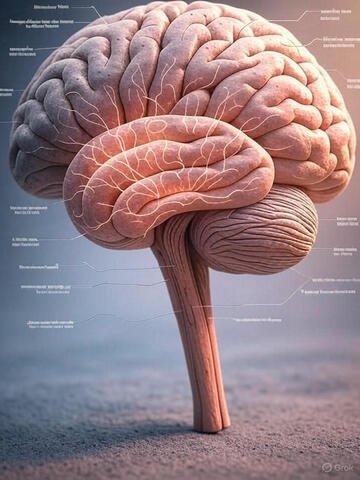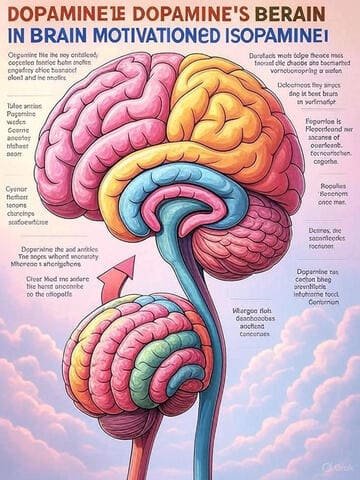which part of your brain is involved in your motivation Ever wonder why some days you’re bursting with energy to tackle your goals, while others you can’t muster the drive to get off the couch? The answer lies in your brain a complex organ orchestrating your motivation like a conductor leading a symphony. Understanding which part of your brain is involved in your motivation unlocks fascinating insights into why we do what we do. From chasing career dreams to sticking to a workout plan, motivation is the spark that keeps us moving. Let’s dive into the science, sprinkle in some real-world examples, and explore how your brain powers your drive.
What Is Motivation, Anyway?
Before we get into the brain’s role, let’s clarify what motivation is. At its core, motivation is the internal push or pull that drives you toward a goal. It’s what gets you out of bed for that 6 a.m. run or keeps you up late finishing a project. Psychologists break it down into two types: intrinsic (driven by personal satisfaction, like learning a new skill for fun) and extrinsic (fueled by external rewards, like a paycheck or praise). Both types rely on a network of brain regions working together. So, which part of your brain is involved in your motivation? Spoiler: it’s not just one spot it’s a team effort.
The Brain’s Motivation All-Stars: Key Regions Involved
Your brain isn’t a single “motivation machine” but a network of regions that collaborate to spark and sustain your drive. Let’s meet the key players.
The Prefrontal Cortex: Your Goal-Setting CEO
The prefrontal cortex, located right behind your forehead, is like the brain’s executive planner. It’s responsible for decision-making, planning, and setting goals crucial components of motivation. When you decide to train for a marathon or aim for a promotion, your prefrontal cortex is hard at work, mapping out the steps and keeping you focused.
For example, consider Sarah, a 32-year-old graphic designer who set a goal to launch her own freelance business. Her prefrontal cortex helped her break down the big dream into manageable tasks: building a portfolio, networking, and learning new software. Without this region, she’d struggle to stay organized or prioritize her goals. Studies, like one from the Journal of Neuroscience (2018), show that damage to the prefrontal cortex can lead to apathy and reduced goal-directed behavior, highlighting its role in motivation.
The Nucleus Accumbens: The Pleasure Seeker
Ever feel a rush of excitement when you accomplish something? That’s your nucleus accumbens, a small region deep in the brain, lighting up like a slot machine. Part of the brain’s reward system, it releases dopamine a feel-good neurotransmitter when you anticipate or achieve something rewarding. This is why checking off a to-do list or getting a “like” on social media feels so satisfying.

Take Jake, a college student who loves gaming. When he beats a tough level, his nucleus accumbens floods his brain with dopamine, reinforcing his drive to keep playing. According to a 2020 study in Nature Neuroscience, the nucleus accumbens is critical for linking rewards to actions, making it a powerhouse for extrinsic motivation.
The Amygdala: The Emotional Spark
The amygdala, an almond-shaped structure, is your brain’s emotional hub. It ties your motivation to feelings, like fear of failure or excitement for success. Ever procrastinated because you were anxious about a task? That’s your amygdala talking. It evaluates whether a goal is worth pursuing based on emotional stakes.
For instance, Maria, a single mom, pushed through night classes to earn her degree because her amygdala associated graduating with pride and a better future for her kids. A 2019 study in Psychological Science found that heightened amygdala activity correlates with stronger emotional motivation, especially when personal values are at stake.
The Ventral Tegmental Area (VTA): Dopamine’s Source
The ventral tegmental area (VTA) is like the brain’s dopamine factory. It sends dopamine to the nucleus accumbens and prefrontal cortex, fueling your desire to chase rewards. When you’re excited about a new project, the VTA is firing on all cylinders.
Think of Alex, an entrepreneur launching a startup. His VTA kicks into gear when he imagines the success of his venture, driving him to work long hours. Research from Neuron (2017) shows that VTA dysfunction can dampen motivation, as seen in conditions like depression, where dopamine signaling is disrupted.
The Anterior Cingulate Cortex: The Effort Monitor
The anterior cingulate cortex (ACC) weighs the effort versus reward of your actions. It’s like the brain’s cost-benefit analyst, deciding if a task is worth your energy. Ever hesitated to start a big project because it felt overwhelming? That’s your ACC calculating the effort required.
For example, Lisa, a marathon runner, relies on her ACC to push through the last grueling miles when her body screams to stop. A 2021 study in Brain and Cognition found that the ACC activates strongly when people choose to persist in challenging tasks, making it a key player in sustained motivation.
How These Brain Regions Work Together
Imagine your brain as a band, with each region playing a unique instrument. The prefrontal cortex sets the melody (your goals), the nucleus accumbens adds the rhythm (reward anticipation), the amygdala brings emotional depth, the VTA supplies the energy (dopamine), and the ACC keeps everyone in sync by balancing effort and reward. Together, they create the symphony of motivation.
But what happens when the band is out of tune? Conditions like ADHD or depression can disrupt this network, leading to low motivation. For instance, a 2022 study in Frontiers in Psychiatry found that reduced dopamine signaling in the VTA and nucleus accumbens is linked to motivational deficits in depression. Understanding this can help us find ways to boost motivation, like therapy or lifestyle changes.
Real-World Examples: Motivation in Action
Let’s ground this science in everyday life. Meet Tom, a 40-year-old teacher who felt stuck in his career. He wanted to become a principal but lacked the drive to pursue further education. After working with a coach, he learned to set small, achievable goals (prefrontal cortex), celebrate milestones (nucleus accumbens), and connect his efforts to his passion for helping students (amygdala). Over time, his VTA fired up with dopamine as he progressed, and his ACC helped him push through tough study sessions. Two years later, Tom became a principal, proving how the brain’s motivation network can transform dreams into reality.

Or consider a case study from Harvard Business Review (2020), which explored how employees at a tech company boosted productivity by aligning tasks with personal values. By tapping into the amygdala’s emotional drive and the nucleus accumbens’ reward system, workers reported higher motivation and job satisfaction.
Expert Insights: What Science Says
Neuroscientists like Dr. John Salamone, a professor at the University of Connecticut, emphasize that motivation isn’t just about wanting something it’s about the brain’s ability to prioritize and act. In a 2018 interview with Scientific American, Salamone explained, “The nucleus accumbens and VTA are critical for translating ‘I want’ into ‘I’ll do.’” Meanwhile, Dr. Nora Volkow, director of the National Institute on Drug Abuse, highlights the role of dopamine in sustaining motivation, noting that imbalances can lead to procrastination or apathy.
These insights remind us that motivation is both biological and psychological. By understanding which part of your brain is involved in your motivation, you can hack your habits to stay driven.
How to Boost Your Brain’s Motivation Power
Want to supercharge your motivation? Here are practical tips to engage your brain’s motivation network:
- Set Clear Goals: Activate your prefrontal cortex by breaking big dreams into small, actionable steps. For example, instead of “get fit,” aim for “walk 20 minutes three times this week.”
- Celebrate Wins: Trigger your nucleus accumbens with small rewards, like treating yourself to coffee after completing a task.
- Connect to Emotions: Engage your amygdala by tying tasks to what matters to you. Want to learn coding? Think about how it could land you a dream job.
- Boost Dopamine Naturally: Exercise, sleep, and a healthy diet fuel your VTA. A 2023 study in Nutritional Neuroscience found that omega-3 fatty acids enhance dopamine release, improving motivation.
- Manage Effort: Use your ACC by prioritizing tasks that balance effort and reward. Start with quick wins to build momentum.
Common Myths About Motivation
Let’s bust a few myths. First, motivation isn’t just willpower it’s a biological process. You’re not “lazy” if you struggle; your brain might need a tune-up. Second, you don’t need to feel motivated to start. The ACC can help you act even when motivation is low starting a task often sparks the drive to keep going. Finally, motivation isn’t one-size-fits-all. What fires up your nucleus accumbens (say, a bonus) might not work for someone else.
FAQ: Your Brain and Motivation
Q: Which part of your brain is involved in your motivation?
A: Motivation involves a network of brain regions, including the prefrontal cortex (goal-setting), nucleus accumbens (reward), amygdala (emotions), ventral tegmental area (dopamine), and anterior cingulate cortex (effort-reward balance).
Q: Can you improve motivation if it’s low?
A: Yes! Set clear goals, celebrate small wins, connect tasks to emotions, and support dopamine production with exercise and sleep.
Q: Does lack of motivation mean something’s wrong with my brain?
A: Not necessarily. Low motivation can stem from stress, poor sleep, or conditions like depression or ADHD, which affect the brain’s motivation network. Consult a professional if it persists.
Q: How does dopamine affect motivation?
A: Dopamine, produced by the VTA and sent to areas like the nucleus accumbens, fuels the desire to pursue rewards, making you feel driven to act.
Conclusion: Unleash Your Brain’s Motivation Potential
Your brain is a marvel, orchestrating motivation through a network of regions working in harmony. The prefrontal cortex plans your path, the nucleus accumbens rewards your efforts, the amygdala ties it to your heart, the VTA fuels your drive, and the ACC keeps it all in balance. By understanding which part of your brain is involved in your motivation, you can take control of your drive and turn goals into reality. Whether it’s starting a new hobby or chasing a big dream, your brain has the tools you just need to use them.
Got a goal you’re struggling to tackle? Share your thoughts in the comments or try one of our tips to kickstart your motivation. For more on how your brain shapes your life, check out our articles on neuroscience and productivity or how emotions drive decisions. Let’s keep the conversation going!
Meta Description: Discover which part of your brain is involved in your motivation. Learn how the prefrontal cortex, nucleus accumbens, and more drive your goals in this engaging guide.
External Links:
Read More- Youth Mental Health First Aid: A Comprehensive Guide to Supporting
Enhancing Focus and Calm: Mindfulness Strategies for ADHD Students

1 thought on “Which Part of Your Brain Is Involved in Your Motivation?”